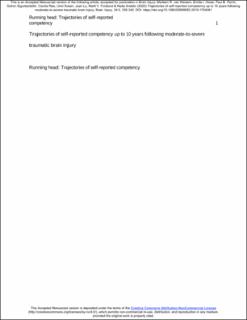| dc.contributor.author | Van Walsem, Marleen Regina | |
| dc.contributor.author | Howe, Emilie | |
| dc.contributor.author | Perrin, Paul B | |
| dc.contributor.author | Sigurdardottir, Solrun | |
| dc.contributor.author | Røe, Cecilie | |
| dc.contributor.author | Sveen, Unni | |
| dc.contributor.author | Lu, Juan | |
| dc.contributor.author | Forslund, Marit Vindal | |
| dc.contributor.author | Andelic, Nada | |
| dc.coverage.spatial | Norway | en_US |
| dc.date.accessioned | 2021-06-04T15:41:09Z | |
| dc.date.available | 2021-06-04T15:41:09Z | |
| dc.date.created | 2020-05-14T17:45:48Z | |
| dc.date.issued | 2020-01-12 | |
| dc.identifier.citation | Brain Injury. 2020, 34 (3), 335-342. | en_US |
| dc.identifier.issn | 0269-9052 | |
| dc.identifier.issn | 1362-301X | |
| dc.identifier.uri | https://hdl.handle.net/11250/2757996 | |
| dc.description.abstract | Objectives: To describe trajectories of self-reported functional competency up to 10 years following traumatic brain injury (TBI) and identify their predictors from baseline socio demographic and injury severity characteristics. Design and methods: Data from 94 participants from a longitudinal cohort of patients with moderate-to-severe TBI were analyzed. Socio-demographic and injury severity data were recorded at baseline. Participants completed the Patient Competency Rating Scale (PCRS) at 1, 2, 5, and 10 years. Hierarchical linear modelling was used to examine PCRS trajectories over time and assess baseline predictors. Results: There was no significant change in average PCRS scores across the follow-up time points in the full sample. Emotional and cognitive competencies had the lowest mean scores. Gender, employment, and the interaction term between gender and time were significant predictors of PCRS trajectories. Females and those who were unemployed at the time of injury showed lower trajectories of self-reported competency. Conclusion: Self-reported competency remained stable from one-year post injury for men only. Lower mean scores in the domains of emotional and cognitive competencies suggest a need for continued rehabilitation focus in the chronic phase after TBI. Special attention to women and individuals who are unemployed at the time of injury may be warranted. | en_US |
| dc.description.sponsorship | This study was funded by the Department of Physical Medicine and Rehabilitation, Oslo University Hospital and The Institute of Health and Society, CHARM (Research Centre for Habilitation and Rehabilitation Models and Services), Faculty of Medicine, University of Oslo. | en_US |
| dc.language.iso | eng | en_US |
| dc.publisher | Routledge | en_US |
| dc.relation.ispartofseries | Brain Injury;Volume 34, 2020 - Issue 3 | |
| dc.rights | Navngivelse-Ikkekommersiell 4.0 Internasjonal | * |
| dc.rights.uri | http://creativecommons.org/licenses/by-nc/4.0/deed.no | * |
| dc.subject | Brain injuries | en_US |
| dc.subject | Outcomes | en_US |
| dc.subject | Competencies | en_US |
| dc.subject | Self-awareness | en_US |
| dc.subject | PCRS | en_US |
| dc.subject | Patient competency rating scales | en_US |
| dc.title | Trajectories of self-reported competency up to 10 years following moderate-to-severe traumatic brain injury | en_US |
| dc.type | Peer reviewed | en_US |
| dc.type | Journal article | en_US |
| dc.description.version | acceptedVersion | en_US |
| dc.rights.holder | © 2020 Taylor & Francis Group, LLC | en_US |
| cristin.ispublished | true | |
| cristin.fulltext | postprint | |
| cristin.qualitycode | 1 | |
| dc.identifier.doi | https://doi.org/10.1080/02699052.2019.1704061 | |
| dc.identifier.cristin | 1811114 | |
| dc.source.journal | Brain Injury | en_US |
| dc.source.volume | 34 | en_US |
| dc.source.issue | 3 | en_US |
| dc.source.pagenumber | 335-342 | en_US |

